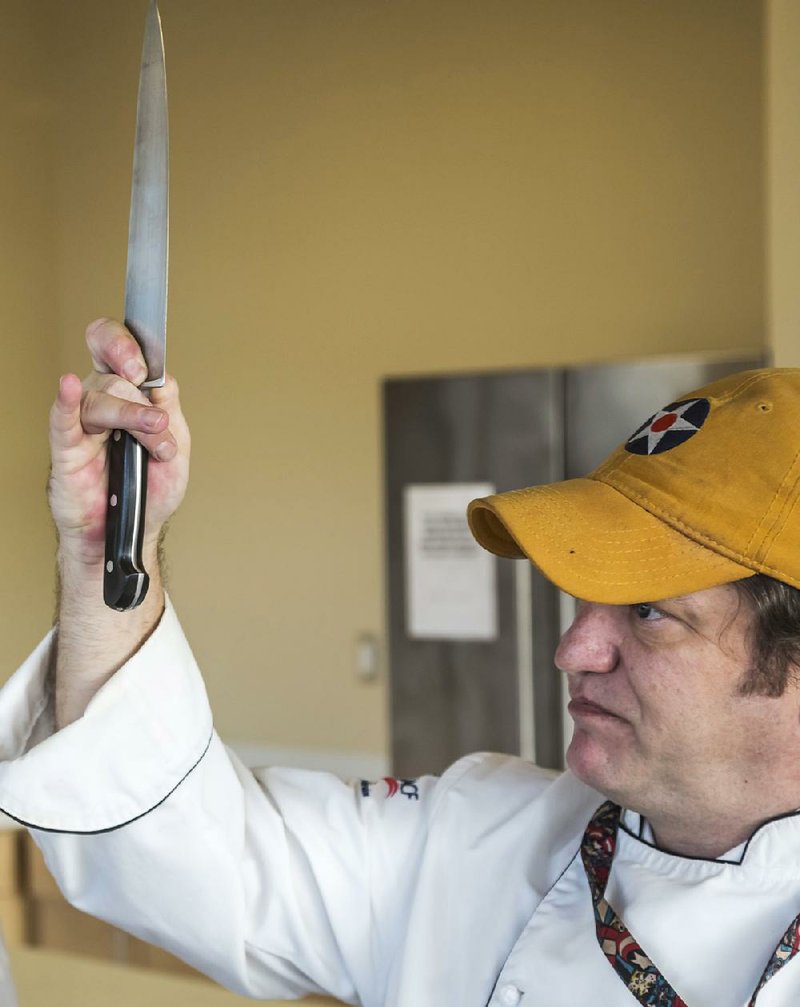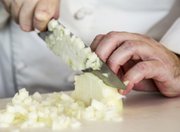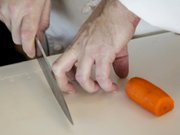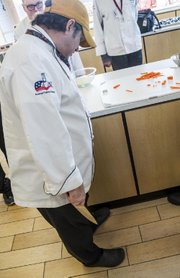"Everything about knifework is about control," says chef Billy Ginocchio, instructor at Pulaski Technical College Culinary Arts and Hospitality Management Institute. "It's making your knife do what you want, and making it easy to do what you want. But it takes practice."
Ginocchio, 8-inch chef's knife in hand, is dismantling a big fat carrot with ninja-like precision in one of the sparkling clean kitchen classrooms on the institute's campus off Interstate 30. He makes it look not just easy, but second nature.
Knife Skills: Cook Like a Pro!
Arkansas Extended Learning Center workshop
2-4 p.m. Sunday, St. Margaret’s Episcopal Church, 20900 Chenal Parkway, Little Rock
Registration: $54 for one; $94 for two
Handling a knife properly goes a long way toward making uniform cuts, which in turn makes cooking easier, Ginocchio says.
"We want uniformity for a few reasons. First a uniformly cut product cooks evenly." Pointing at misshapen clumps of dull orange carrot on his cutting board, he notes that the smaller pieces will be "almost unpalatable" while the larger ones will still be raw if they were going into the same dish.
"We want our food to cook consistently," he says, "so the cuts need to be consistently sized for cooking."
That same consistency also makes food look better and, for the home cook or the seasoned pro, good-looking fare is always a nice ego boost.
HANDLE IT
Ginocchio is at a wooden-topped workspace in the kitchen classroom and is talking about the parts of the chef's knife he is using on the carrot.
The handle and blade are obvious; then there's the heel of the blade near the handle. Knives also have a spine, a tip, a point and other parts. But it's the bolster -- the thick part between the blade and the handle -- that Ginocchio is focused on when talking about how to handle a blade for food preparation, because the way you hold a knife is probably wrong. It all goes back to the control thing.
"This is hard to control," he says, holding the knife by its handle the way most people probably would.
"This is like a weapon," he adds, gripping it in his fist like the maniac chasing people through the woods in a slasher flick.
The correct way, he says, uses the bolster and the knife's natural balance. The middle finger rests along the bolster with the thumb on the other side.
"You're really holding the knife with just two fingers," he says. "The rest of the fingers do something, of course, but the main part of the grip is right there."
With the thumb and middle finger gripping the knife, the index finger curls onto the blade over the bolster and the other two fingers hold the handle against the heel of the hand for control and stability.
"You're not gripping it super tight because you can't control it and you will wear yourself out," Ginocchio says. "Use as light of a grip as you can."
Yes, it feels weird, but practice makes perfect.
What also feels weird is standing, or at least standing the way Ginocchio does when he's cutting up a vegetable.
STANCE
With the edge of his cutting board squared off with the edge of the table, he stands with his back foot -- in this case his right foot, as he holds the knife in his right hand -- parallel to the table and his left foot pointing toward the table. In this stance, he is parallel to the table.
"If I pivot just slightly around, I'm standing here and my knife is automatically coming down more perpendicular to the table and my board," Ginocchio says. "That means that I can look down my knife and see if I've got a square cut."
Standing and looking straight across the table, he says, makes it hard to see if his knife is cutting at the same angle for every cut, and the cuts are important.
"Cuts are defined on purpose. It's not because we're being arbitrary. When we say 'small dice,' it means something. It means 1/4-inch, cubed cuts."
And it all goes back to control.
"The point is, I can control my knife so I can get cuts like these. One of the hardest things in our food production classes is to get students who have been doing it wrong to do it right," he says. "They're uncomfortable with the grip. They're uncomfortable with the stance. I've been known to go by and kick their back foot."
And while they may have grumbled during class, Ginocchio says many of his students realized later how important those lessons were.
"They hated me while I was doing it, but it always seems like two semesters later, they're running up and saying, 'Thank you
because now I can do it so much better.'"
DEAD SPIDERS
All that good form and proper gripping of the knife doesn't mean much if you've chopped all your fingers off, which is where the "dead spider" comes in.
Ginocchio is still working on that carrot. Since it's round, he has made it easier to handle by shaving it on one side to make it sit flat on his cutting board.
"I want you to think of a dead spider," he begins. "A dead spider curls up, right?" He's holding his hand in a gnarled, half-fist that does sort of resemble a dry, lifeless arachnid in some dusty corner.
With his hand in this position, he holds the carrot. His fingertips are tucked down and his middle finger, which is slightly forward, actually touches the side of the blade.
"It's a guide for my knife," Ginocchio says. "If the flat of my blade is always touching that knuckle, I always know where the knife is and I'm not likely to cut myself."
The index finger, ring finger and pinkie hold the carrot while the thumb pushes it forward as Ginocchio slices with steady precision.
He's also using the whole blade of the chef's knife.
"This blade was designed for that, to plant the tip and follow the blade of the knife through," he says. "The idea is to let the knife do the work instead of you."
Later, Ginocchio made a few cuts into a fresh, white onion (after slicing one side so it would sit flat, of course) and handed the knife to your jittery Style correspondent.
Stance is mostly correct, left hand is in a sort-of dead spider pose and holding the onion, thumb ready to push it along. The knife is in the right hand as Ginocchio helps with establishing the proper grip, and it's time to cut this thing up.
A few slices in, when the edge of the wickedly sharp blade gets a bit too close to the middle finger, your correspondent gladly hands the knife back to the chef before any serious damage is done.
"It takes practice," the chef says.
CLASSES
There are a couple of opportunities in central Arkansas to hone one's knife prowess in the kitchen.
The Arkansas Extended Learning Center is holding a hands-on workshop called Knife Skills: Chop Like a Pro! from 2-4 p.m. Sunday, St. Margaret's Episcopal Church, 20900 Chenal Parkway, where participants can learn "basic knife techniques for mincing, dicing" and also how to select, sharpen and care for knives. Registration is $54 per person or $94 for two. The class will be offered again in April. For a complete list of classes at AELC, visit extendedlearning.org.
Amanda Ivy, sous chef at Little Rock's 1836 Club and frequent instructor of the knife skills workshop, says learning to use knives safely and how to make uniform cuts is important for amateur cooks.
"Rule Number One is safety," she says. "We learn about keeping our fingers back and using our knuckles as a guide. And also, even cooking. When you're going to bake or saute something, it's important to have the same size vegetable in that dish. You don't want something burnt over here and undercooked over there."
Ivy won't be teaching Sunday's class -- that duty goes to her 1836 line cook Sammy Cyz -- but when she does teach, especially in the winter, she likes to have her students tackle sweet potatoes and other root vegetables. She also brings things that will go well together in a salad and teaches techniques that make cooking at home easier.
"I always like to show people how to cut an onion, because there are a few little tricks that make it faster," she says.
Ginocchio teaches a six-week community education class at the culinary institute called Cook Like a Pro that also tackles knife skills. In the first session, Knife Skills and Flavor, "You will learn how to efficiently use a knife in the kitchen and how to produce cuts that will make your food stand out," according to class materials. A bonus seventh week for students who participated in all previous six weeks will include a Chopped-style competition, complete with mystery baskets and prizes.
Cost is $400 for the entire series or $75 for individual classes. Dates for this year's classes aren't set, but they will begin in June at the Institute's Community Education Kitchen. Check pulaskitech.edu for information.
Food on 02/08/2017



